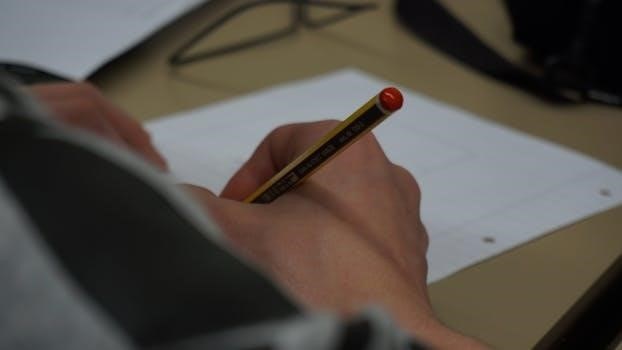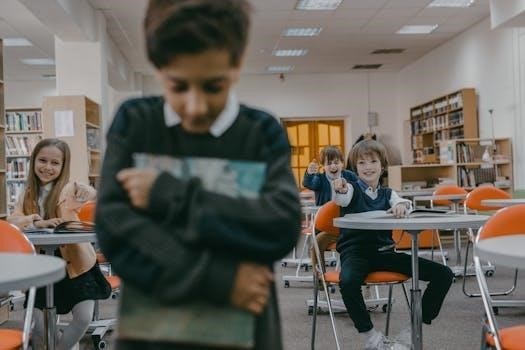Classroom management is a cornerstone of effective teaching․ It involves establishing clear expectations, fostering positive relationships, and using proven techniques to create a productive learning environment, thus aiding student success․
The Importance of a Classroom Behavior Manual
A classroom behavior manual is crucial for establishing a clear and consistent learning environment․ It serves as a guide for both teachers and students, outlining expectations, rules, and procedures․ This manual promotes a positive atmosphere, reducing disruptions and enhancing learning․ A well-defined manual also provides a framework for addressing inappropriate behavior fairly and consistently․ It ensures that all students are aware of the boundaries and consequences, fostering a sense of security and predictability․ Furthermore, it facilitates effective communication between teachers, students, and parents, clarifying the standards of conduct and promoting shared responsibility for a harmonious classroom․ By having a clear manual, teachers can spend more time on instruction and less on managing behavior, thereby boosting student engagement and academic success․
Establishing Clear Expectations
Clear expectations are the foundation of a well-managed classroom; They involve defining rules and procedures, communicating them effectively, and ensuring students understand them for success․
Defining Classroom Rules and Procedures
Establishing clear classroom rules and procedures is crucial for creating a structured and predictable learning environment․ These rules should be concise, easy to understand, and positively stated, focusing on desired behaviors rather than prohibitions․ Procedures, on the other hand, outline the steps for daily routines, like entering the classroom, asking for help, or transitioning between activities․ Involving students in the rule-making process can foster a sense of ownership and responsibility․ Regularly reviewing these rules and procedures is essential to ensure students internalize them․ This process promotes a consistent and respectful atmosphere, leading to a more productive and engaging learning experience for all students involved in the classroom․
Communicating Expectations Effectively
Effectively communicating classroom expectations is paramount for ensuring students understand what is required of them․ This involves not only stating rules and procedures clearly but also demonstrating them through modeling and examples․ Teachers should use simple language and visual aids when necessary, ensuring all students can comprehend the expectations․ Consistent communication is key, with regular reminders and reviews throughout the school year․ It’s also important to be proactive, addressing potential issues before they escalate․ Furthermore, teachers should be approachable and open to questions from students, fostering an environment where they feel comfortable seeking clarification․ This clear and consistent communication will help students understand and follow classroom expectations, contributing to a positive and productive learning environment․

Building Positive Relationships
Positive relationships are fundamental to classroom management․ Fostering connections between students and teachers, and promoting positive peer interactions, creates a supportive learning environment for all students․
Fostering Student-Teacher Connections
Building strong student-teacher connections is vital for effective classroom management․ Teachers can demonstrate care by getting to know students and families, showing genuine interest in their lives, and communicating clearly and regularly․ Modeling ideal behavior and taking charge of the classroom fosters an environment of trust and respect․ By creating a supportive atmosphere, students are more likely to be engaged and motivated․ Effective teacher communication, combined with a caring demeanor, enhances the learning experience and promotes a positive classroom environment, thus reducing potential behavioral issues․ This approach prioritizes building mutual trust and respect․
Promoting Positive Peer Interactions
Cultivating positive peer interactions is essential for a harmonious classroom․ Teachers can facilitate this by encouraging collaboration and teamwork through group projects and activities․ It is important to help students learn effective communication skills and conflict resolution techniques; Positive reinforcement can be used to promote acts of kindness and cooperation․ Creating a class charter where students contribute to establishing guidelines for respectful interaction can also foster a sense of ownership and responsibility within the classroom․ It is important to encourage empathy and understanding among students, allowing them to appreciate their differences and support one another․ By actively promoting positive interactions among students, teachers can help build a collaborative and respectful learning environment․

Effective Classroom Management Techniques
Effective techniques include positive reinforcement, consistent discipline, and using the 5 Ps⁚ Prompt, Polite, Productive, Patient, and Prepared․ These strategies help establish a positive and structured classroom․
Using Positive Reinforcement and Praise
Positive reinforcement and praise are powerful tools in classroom management․ When students demonstrate desired behaviors, such as active participation or following rules, acknowledging their efforts with specific praise can encourage them to repeat these actions․ This approach creates a positive classroom culture where students feel valued and motivated․ It is essential to make praise genuine and specific, focusing on the behavior rather than the student’s personality․ For instance, instead of saying “good job,” try “I really appreciate how you actively listened during the lesson․” Consistent use of positive reinforcement builds student confidence and promotes a positive learning environment․
Implementing Consistent Discipline
Consistent discipline is crucial for maintaining order and respect in the classroom․ When misbehavior occurs, addressing it calmly and consistently helps students understand the consequences of their actions․ This approach involves having clear rules and procedures, ensuring that all students are aware of them․ Discipline should be fair and applied equally to all students, avoiding favoritism․ When implementing consequences, it’s essential to focus on correcting the behavior rather than punishing the student․ This approach helps students learn from their mistakes and encourages them to make better choices in the future․ Consistency creates a predictable environment that promotes both safety and learning․
The 5 Ps of Classroom Management
The 5 Ps serve as a valuable framework for promoting a positive classroom culture․ They emphasize five key principles⁚ Prompt, Polite, Productive, Patient, and Prepared․ Being prompt means starting and ending activities on time, respecting the class schedule․ Polite behavior involves showing respect towards peers and teachers through actions and words․ Productive focuses on engagement in learning tasks and achieving set goals․ Patient encourages tolerance and understanding when facing challenges․ Lastly, being prepared entails having all the necessary materials for effective learning․ By prioritizing these 5 Ps, educators can establish clear expectations and create an environment that encourages positive behavior and academic success․

Addressing Inappropriate Behavior
Managing disruptive students requires proactive strategies and consistent responses․ Addressing inappropriate behavior promptly and fairly is essential for maintaining a positive learning environment for all students․
Strategies for Managing Disruptive Students
Effective management of disruptive students involves a multifaceted approach․ Start by understanding the root cause of the behavior․ Employ non-verbal cues, such as proximity control, to redirect attention․ Use simple verbal reprimands calmly and privately․ Offer choices and involve the student in finding solutions․ Implement consistent consequences, ensuring they are fair and aligned with established classroom rules․ Provide opportunities for students to work ahead and deliver presentations to share key points․ Promote a growth mindset, and remember to model ideal behaviors․ It’s crucial to maintain a positive and respectful tone while addressing the behavior․ Periodically review classroom rules and procedures․

Modern Tools and Strategies
Integrating technology can enhance engagement․ Brain breaks and active learning strategies promote focus and reduce disruptive behaviors․ These modern approaches create a dynamic and positive environment․
Integrating Technology for Engagement
Technology offers dynamic ways to engage students and manage behavior․ Digital tools like interactive whiteboards and educational apps can capture attention and offer varied learning experiences․ Platforms like ClassPoint allow teachers to create interactive lessons, and provide immediate feedback, increasing student participation and motivation․ Online quizzes and polls can assess understanding and provide real-time insights, allowing for timely interventions․ Virtual reality can also offer immersive experiences, bringing abstract concepts to life and fostering a deeper understanding․ Utilizing these modern tools can also promote a positive learning environment by making learning fun and exciting, thereby reducing disruptive behaviours․
Utilizing Brain Breaks and Active Learning
Incorporating brain breaks and active learning is crucial for managing student behavior effectively․ Short, structured breaks involving physical activity or mindfulness exercises can help students refocus and reduce restlessness․ Active learning strategies, such as group discussions, hands-on activities, and movement-based tasks, encourage participation and engagement․ These approaches can prevent boredom and fatigue, which often contribute to disruptive behavior․ By using diverse teaching methods that involve movement and interaction, we can cater to different learning styles and keep students energized․ Brain breaks and active learning can be seamlessly integrated into lessons, thus enhancing both engagement and classroom management․
